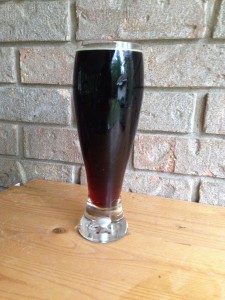High-gravity brewing allows you to brew a larger volume of beer than your available fermenter volume. The basic idea is to brew a strong beer and then dilute it to the desired strength in the keg or bottling bucket. High-gravity brewing works best for low-gravity beers (below 11 °Plato/OG 1.044), but can be used for moderate strength ales (under 14 °Plato/OG 1.056) with good results. For example, if you were brewing a mild ale, you could brew 5.0 gallons (19 L) of a roughly 5% ABV ale and blend it down to 6.0 gallons (23 L) of a roughly 4% ABV mild with de-aerated water. You wouldn’t, however, want to try to brew a Belgian-style tripel by brewing an “imperial tripel” and diluting it. The result would most likely be an ester-laden mess from the fermentation of the very strong beer.
High-gravity brewing works best when you plan to consume the beer within a couple months. Given that the dilution water will carry some dissolved oxygen, high-gravity brewed beer is primed to stale faster than regular homebrew.
How Much Volume?
Using high-gravity brewing in a home brewery is fairly simple. First, determine how much beer your fermenter(s) will hold. Generally, allot the beer volume plus roughly 20% to allow for the kräusen during fermentation. So, for example, a 6.0-gallon (23-L) carboy can ferment 5.0 gallons (19 L) of beer. The amount of headspace required varies with yeast strain, fermentation temperature and any other variable that affects fermentation vigor. So use 20% as a guideline, not as a hard and fast rule.
Next, decide how much water you are going to add. In commercial practice, the volume of the beer is increased by a factor of roughly 1.5. For every barrel of strong beer brewed, the brewery yields 1.5 barrels of beer at working strength. At home, I would recommend an expansion ratio of around 1.2 — enough to expand 5.0 gallons (19 L) of beer to 6.0 gallons (23 L). This gives you enough more beer to be worthwhile, but the risk of prematurely staling is lowered (since you can’t de-aerate your blending water at home to the extent that commercial brewers do).
Multiply your fermenter capacity by your expansion factor to yield your target volume of beer. For example, if you have a 6.5 gallon (25 L) carboy, and figure you can brew 6.0 gallons (23 L) of beer in it, multiply 6 times 1.2 to yield 7.2 gallons (27 L).
Recipe Considerations
Now formulate your beer recipe for this target volume or scale an existing recipe to this volume. To scale any recipe, take the volume of the target beer and divide by the volume of the original recipe. Building on the previous example, let’s say we have a 5-gallon (19-L) dry stout recipe and we were going to brew 7.2 gallons (27 L) of beer. 7.2 divided by 5 is 1.44 — this is ratio of our target volume to the volume of our recipe to be scaled. Multiply the amount of each ingredient in the recipe by this factor to yield an ingredient list for a 7.2 gallon (27 L) batch of beer. For example, let’s say our 5.0-gallon (19-L) recipe called for 6.50 lbs. (2.95 kg) of English pale ale malt, our 7.2 gallon (27-L) recipe would require 6.50 lbs. X 1.44 = 9.36 lbs. (4.25 kg) of pale ale malt. Do this for the amount of every malt, grain, malt extract, hop, sugar or other ingredient or processing agent (such as Irish moss).
Brew It

Conducting on ordered fermentation on the strong beer is of the utmost importance when high-gravity brewing.
Then, brew the strong beer by using the recipe for the target beer, but yielding only as much wort as your fermenter(s) will hold. In our example, we’d brew the 7.2-gallon (27-L) recipe, but end up with 6.0 gallons (23 L) of fermented beer. The fermented beer will, of course, be stronger than you intended. In our example, if the OG of our dry stout was supposed to be 1.040, and yield a roughly 4.0% ABV beer, the strong beer would be 1.2 times stronger — an OG 1.048 beer with roughly 4.8% ABV. Be sure to make an appropriately-sized yeast starter and aerate your wort well. Likewise, don’t let the fermentation run of the strong beer run too warm. Running a good fermentation on the strong beer is absolutely necessary to yield a quality target beer.
Blend It
When the strong beer is finished, boil the required amount of water to expand your beer. Take the difference between your target volume and strong beer volume, add about a quart (~ 1 L), and boil this vigorously for 15 minutes. This will greatly reduce the amount of dissolved oxygen in the water, hopefully to around 1 ppm. The extra quart (liter) should be at least mostly evaporated during the boil. Cool the blending water as quickly as possible to roughly the temperature of your beer. Do not splash or otherwise aerate the water during cooling. (If you have a CO2 cylinder and an airstone, bubbling some CO2 through it may knock more oxygen out of solution.)
Pour the correct volume of blending water into the bottling bucket or keg(s), and siphon the beer into it. Stir to mix the two liquids thoroughly. You may have to do this in shifts. To continue with our example, if our bottling bucket won’t hold 7.2 gallons (27 L), add half of the water to the bucket and half the beer. Bottle that, then repeat (perhaps re-boiling the blending water). Likewise, if you’re kegging the beer and more than one keg is required, either spread the blending water and beer equally between kegs, or better yet, figure out how to add it proportionally to yield one or more full kegs and only one partially-filled keg.
Twists

The shelf life of high-gravity brewed beer will be shorter than ordinary homebrew, so don’t cellar your hg-brewed creations.
Beyond the obvious idea of making more beer, there are a couple things you can try with high-gravity brewing, given the typical equipment employed. For example, you could brew 5.0 gallons (19 L) of strong beer, bottle 0.8 gallons (3.0 L) as strong beer, then expand the remaining 4.2 gallons (16 L) to 5.0 gallons (19 L) in a keg. Essentially, your brewday would yield 5.0 gallons (19 L) of the beer you wanted, with the bonus of eight extra 12-oz. (355-mL) bottles of strong beer.
Likewise, sometimes you may want to hit a certain volume of beer when kegging. For example, if you had three empty 5.0-gallon (19-L) Corny kegs, but not 15 gallons (57 L) of fermenter space, you could fill all three kegs if you found 12 gallons (45 L) of fermenter space (perhaps from two 6.5-gallon/25-L carboys). This would expand the beer by 1.25X. If you had three fermenters that yielded 5.0 gallons (19 L) each, you could expand that into 20 gallons (76 L) — four full Corny kegs — by expanding the beer by 1.33X.
If you have the fermenter space, brewing your beer at working strength is your best option. However, if you’ve got to yield a lot of beer in a hurry, high-gravity brewing is worth a try.
Tomorrow, I’ll examine beer styles that are a good candidate for this treatment.



Great post Chris. I have recently started brewing 10gallon batches with my keggle and always end up with less than 10 gallons into the ferment or and about 8 gallons into the 2 kegs. I always wondered if just adding sterile water to the kegs would help me hit my target volume at the expense of gravity. Now I know!!
Once I get my system figured out I can yoeld from each 10 gallon batch but for now this idea definitely supports the practice of adding water post ferment.
What do you think of adding water to fill the term enters to appropriate per ferment volume?
If you are trying to brew 10 gallons of beer, but are only yielding 8 in the fermenter(s), add water to the fermenter(s), provided you have the space. Adding water to the fermenter before you pitch your yeast is going to be better than adding the water in the kegs after fermentation. Whatever oxygen is in the water you add to the fermenter before you pitch is going to promote yeast health. Oxygen dissolved in the dilution water added to the keg is going to prime the beer for staling. In addition, adding water in the fermenter will bring down the OG a little, giving the yeast an easier time during fermentation.
What do you think of kegging the de-oxygenated water?
I am thinking to boil 6 gallons of water 15 min. Then run it hot into a clean, sanitized, CO2 flushed, corny keg. While still warm I will purge the headspace with CO2, charge it to 30 PSI (so the lid doesn’t fall in as it cools), and then let it cool to ambient. Give it another blast of CO2 from time to time to make sure the lid stays tight…
I am planning a 12 gallon brew this weekend with the idea that I will get 3 kegs out of it at packaging. Probably make the deoxygen water about 3 days before kegging as I want to infuse 1 gallon of the DO water with raw cucumber before it goes into the keg.
Kegging sounds like a good idea. You could even carbonate the water, which would speed the carbonation of the blended beer,